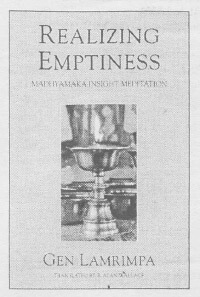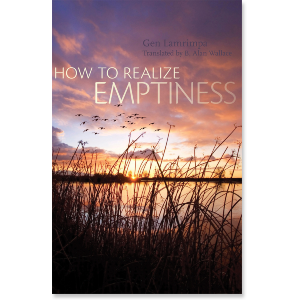| The following article is from the Autumn, 2002 issue of the Snow Lion Newsletter and is for historical reference only. You can see this in context of the original newsletter here. |

This book offers experiential and analytical approaches to this most important and difficult topic in Buddhism.
During a long retreat on the west coast, Gen Lamrimpa drew on his theoretical training as well as his years of solitary meditative experience to show students how they can gain realization of ultimate reality. He explains in a practical and down-to-earth fashion how to analyze experience to fathom how it has been misperceived and misunderstood because of our many delusions, and how to use Madhyamaka reasoning to experience how all things only exist as dependently related events rather than in themselves.
"Not quite emptiness made easy' (an impossibility) but it is at least emptiness made comprehensible'."—Dharma Life
"Written by an genuine Buddhist master, Realizing Emptiness gives us accurate directions to explore the nature of reality. By refuting inherent existence and establishing illusion-like conventionalities, we can come to the correct view of the Middle Way."—Thubten Chodron
Gen Lamrimpa was born in Tibet in 1934 and lives in Dharamsala, India. He has also authored Calming the Mind. B. Alan Wallace lives in Santa Barbara, CA and is the author of many books.
Below is an excerpt from Realizing Emptiness.

Valid and Invalid Ways of Postulating the Self
I would now like to review a major point, namely that the truly existent "I" is grasped on the basis of the conventional "I." The conventional "I" is apprehended on the basis of the aggregates and therefore, if we assume that the truly existent "I" does in fact exist, we can posit that it is in fact the aggregates. Having adopted that hypothesis, we can examine the consequences of that position and see how those consequences undermine the initial premise. Alternatively, if there is a truly existent "I" and it is not identical with the aggregates, it must be distinct from the aggregates. When we again examine the consequences from this premise, we identify all the aggregates, set them aside analytically, and then seek out the "I" but no such "I" is to be found. Here is the essential point: Conventionally speaking, the "I" is distinct from the aggregates, but no truly existent "I" can be established as distinct from the aggregates.
Let's now consider the notion of the self as a stream of consciousness by first investigating whether or not a stream of consciousness truly exists. In this regard, we may posit "true existence" in two ways: true existence in dependence upon other phenomena, and true existence that is independent of other phenomena. Ignorance apprehends the self as being truly existent, as something that is independent of anything else. This is how ignorance apprehends true existence. But there is another way of speaking of true existence, and that is by determining whether or not something is conventionally true. Speaking in this fashion does not imply that the object under investigation exists independently of anything else. For example, we may ask whether a person who appears on the television screen is a true person. The answer is no; it is not a true person. Next we can go on to ask whether this appearance of a person is truly an appearance of a person on the television screen. And here the answer is yes; the appearance is true. There truly is an appearance of a person on the television. Similarly, while looking in a mirror, I may look at the reflection of my face in the mirror and ask, "Is that my face?" The answer is "No, this is not my face." If this were truly my face, then it would have to have flesh and bones and so forth, but the image of the face in the mirror does not have those components. The reflection in the mirror is false in terms of being a face; even though it appears to be a face, in fact it is not one. But it truly is a reflection of a face. Just as the face in the mirror is not truly a face, so also is the true existence that is apprehended by ignorance untrue.
Now we may ask, "Are there then no true phenomena?" The answer is, of course, that there are many true phenomena. There is the true Buddha, the true Dharma, the true Sangha, and many other things that are true also. So now let's examine the suggestion that the continuum of consciousness is truly existent. What is meant by "continuum"? The term "continuum" is designated upon many sequential components. It has components and attributes, and they are all subject to change. But apart from those changing components and events, one cannot posit the existence of a continuum. So we must ask if this stream of consciousness is truly existent in the manner in which ignorance apprehends phenomena as being truly existent. The answer is no, it is not. Once again, consider what is meant by a continuum: it is something designated upon many components. Apart from the many components that make up the continuum, there is no way to judge that something is a continuum. Since by definition a continuum is something designated upon many parts, for that very reason the continuum must be deemed false in the sense of not being truly existent.
To illustrate the fact that consciousness is dependent upon the body, we can use the very fact that the variations of clarity of consciousness are dependent on such influences as our diet, our health, and so forth. As one fluctuates, so does the other fluctuate. There are certain physical causes for the degree of clarity of consciousness, so this already suggests that consciousness is not truly existent in the manner described previously. Furthermore, the very fact that one's consciousness yesterday may have been unclear whereas today it may be clear also suggests that consciousness is not truly existent. Unclear consciousness is surely influenced by other causal factors. Moreover, as unclear consciousness comes under the influence of other caused factors, it may transform into clear consciousness. Therefore, the hypothesis that this continuum of consciousness is truly existent in the sense that it is immutable is refuted.

Just as the face in the mirror is not truly a face, so also is the true existence that is apprehended by ignorance untrue.
Even the buddha-nature is something that is conceptually designated. Emptiness, too, is something that is conceptually designated. The mutual dependence between awareness and the object of awareness relates to the buddha-nature as well. If there is mutual interdependence in general between the object of awareness and the awareness, then more specifically the awareness that establishes buddha-nature and the buddha-nature which is the object of that awareness must also be mutually interdependent. In the absence of one, the other cannot be present. So anything that comes into existence through the power of being conceptually designated does not inherently exist; it does not truly exist. If there were something that did exist but was not conceptually designated, that would be truly existent. The process of conceptual designation is something quite forceful; there is nothing there from the object's own side, but things are forcefully imputed upon it conceptually. Thus, since the object is dependent on that designation, it does not truly exist.
In the Dzogchen, or Great Perfection, tradition, there are statements suggesting that what is called innate mind (Tib. nyug sems), or awareness (Tib. rig pa), is truly existent. Here the innate mind is said to be truly existent in the sense that it does not undergo fluctuations or changes, as do thoughts and conceptual states of mind. But the very term "awareness" is something that can be designated in relationship to its opposite: nonawareness (Tib. ma rig pa), or ignorance. Because awareness is established in relationship to its opposite, it cannot therefore be truly existent in the Madhyamaka sense of the term. Moreover, the innate mind is posited in contrast to fluctuating states of mind, so this term is also designated in relationship to something else. Therefore, it too cannot be truly existent.


